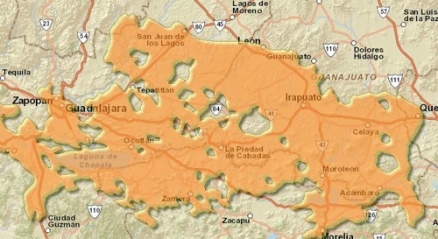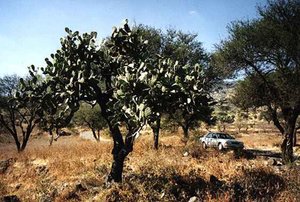Bajío dry forests
Located in the west central section of México, the topography of the Bajío dry forests ecoregion consists of steep slopes, canyons,and valleys. One of the most developed areas in México, little remains of the original forest; patches of original habitat, scarcely larger than twenty square kilometres remain intact. Part of this ecoregion is an Endemic Bird Area, although little is known of the biodiversity of this region. One protected area exists around Chapala Lake. More are needed to save the remaining habitat from cattle farming and industry, which have virtually extirpated the original forest.
Contents
Location and general description
This ecoregion is situated in western central Mexico, and forms part of the central trans-volcanic belt. Topography varies and consists of valleys (between 1000 and 2000 metres above sea level) interspersed with steep slopes and canyons. Soils tend to be shallow, well-drained, and rocky, and are predominantly derived from volcanic (Igneous rock) and sedimentary rocks, especially limestone. The climate is tropical subhumid, with precipitation levels between 500 to 930 millimetres per year (mm/year), with a long dry season that can last up to eight months. According to Rzedowski and McVaugh, major habitats include areas of true dry forests interspersed with extensive areas of subtropical scrub. A majority of the ecoregion grows on the slopes of deep canyons, bounded by pine-oak forests of the trans-volcanic belt at higher elevations, and deciduous forests at lower elevations. Once dominated by deciduous forests, the habitat is now a mosaic of forest patches, thorn scrub, and subtropical matorral. The forested areas are dominated by tree species such as Bursera copallifera, B. palmeri, B. bipinnata, Ipomoea intrapilosa, I. Murucoides, Ceiba aesculifolia, Euphorbia fulva, Leucaena glauca, and Lysiloma divaricata. The scrub stratum is composed mainly of Acacia farnesian, and Eysenhardtia polystachya, and herbaceous stratum is composed of Bouteloua filiformis, B. curtipendula, Hilaria cenchroides, Muhlenbergia stricta, and M. rigida. Thornscrub habitats are dominated by mesquite (Prosopis laevigata) and huamúchil (Pithecellobium dulce), and interspersed with saltgrass (Distichlis spicata) and Eragrostis obtusiflora. Subtropical matorral habitats consist of Acacia pennatula mixed with other Acacia, Ipomoea and Bursera, interspersed with Opuntia, and Stenocereus.
Biodiversity features
.jpg) Vampire bat (Desmodus rotundus). (Source: Photograph by Bat Conservation International)
Vampire bat (Desmodus rotundus). (Source: Photograph by Bat Conservation International) The Bajío dry forests have been severely disturbed by urban expansion, dating back many centuries. Dry deciduous forests once covered over 11,000 square kilometers (km2) of this ecoregion, but now exists only as small remnants, each no larger than 20 km2, which are confined to ridges and isolated peaks. The dry forests were once extensive, stood 6-12 meters tall, and contained almost 6000 trees per hectare, representing 57 different species. Challenger confirms that in the past these forests must have covered a vast area, allowing for the radiation and speciation of many birds. The current landscape consists of a mosaic of human use, scattered marshes and lakes, and forested patches in various states of succession. A prominent feature, in terms of biodiversity, is Lake Chapala, which supports a rich and endemic ichthyofauna that is currently in danger of extinction. In other aspects, this region is poorly known in terms of its biodiversity features. Part of this ecoregion is covered by the Central Mexican marshes Endemic Bird Area.
Mammals include Mexican wolf (Canus lupus baileyi), and pocketed free-tailed bat (Nyctinomops femorosaccus).
Birds include Black-throated magpie jay (Calocitta colliei), thick-billed kingbird (Tyrannus crassirostris), whiskered screech owl (Otus trichopsus), orange-fronted parakeet (Aratinga caniculanis), dwarf vireo (Vireo nelsoni), and black-polled yellowthroat (Geothlypis speciosa).
Ecoregion status
The Bajío dry forests are situated in one of the most developed areas (in terms of industry and agriculture) in México. Agriculture, cattle farming and the textile industry were well developed by the beginning of the 18th century, and the soil and topography were ideal for human exploitation. As a result only 5% of the original habitat remains, much of which is in successional stages. Endemic species that this region once contained are now facing extinction. Only one protected area has been established to preserve the region of the Chapala lake, and the surrounding dry forest. Another three areas have recently been proposed. Several Important Bird Areas have been identified within this ecoregion, including Cuitzeo, Laguna De Chapala, and Laguna De Yuriria. Comisión nacional para el conocimiento y uso de la biodiversidad (CONABIO) has recently identified a set of terrestrial priority regions for Mexico, several of which partially occur in this ecoregion. These include Cerro Viejo-Sierras de Chapala and Cerro Ancho-Lago de Cuitzeo.
Types and severity of threats
Cattle and sheep grazing have also been a major source of forest destruction (Land-use and land-cover change). Mining is an additional threat. In Guanajuato, the mining industry caused the destruction of large portions of dry forests at the time the Spanish controlled Mexico.
Justification of ecoregion delineation
This ecoregion was delineated to encompass the dry forests of the Bajío area, which contains marked species endemism. Initial linework and classification was determined following Instituto Nacional de Estadística Geografía e Informática (INEGI) current landcover maps, Rzedowski, and expert opinion from ecoregion workshops to encompass these unique forests. Because most of this landscape has been converted to agriculture, the expert opinions of Rzedowski were the primary factors influencing the linework presented here. This ecoregion is distinguished from the Balsas dry forests to the south by the Trans-Mexican volcanic belt which acts as a formidable barrier to some species dispersal.
Further reading
- Arriaga, L., J. M. Espinoza, C. Aguilar, E. Martínez, L. Gómez, y E. Loa (coordinadores). 2000. Regiones terrestres prioritarias de México. Escala de trabajo 1:1 000 000. México: Comisión Nacional para el Conocimiento y uso de la Biodiversidad.
- Benitez, H., C. Arizmendi, y L. Marquez. 1999. Base de datos de las AICAS. Mexico: CIPAMEX, CONABIO, FMCN y CCA.
- Challenger, A. 1998. Utilización y conservación de los ecosistemas terrestres de México. Pasado, presente y futuro. México: Conabio, IBUNAM y Agrupación Sierra Madre.
- CONABIO Workshop, 17-16 September, 1996. Informe de Resultados del Taller de Ecoregionalización para la Conservación de México.
- CONABIO Workshop, Mexico, D.F., November 1997. Ecological and Biogeographical Regionalization of Mexico.
- Dirzo, R. 1992. Diversidad florística y estado de conservación de las selvas tropicales de México. Pages 283-290 in J. Sarukhán, y R. Dirzo, editors, México ante los retos de la biodiversidad. México: Conabio.
- Dirzo, R. 1994. In: Robles-Gil, editor, Mexican diversity of flora. México: Cemex y Sierra Madre. ISBN: 968639740X
- INEGI Map (1996) Comision Nacional Para el Conocimiento y Uso de la Biodiversidad (CONABIO) habitat and land use classification database derived from ground truthed remote sensing data Insitituto Nacional de Estastica, Geografia, e Informática (INEGI). Map at a scale of 1:1,000,000.
- Rzedowski, J. 1978. Vegetación de Mexico. Editorial Limusa. Mexico, D.F., Mexico.
- Rzedowski, J. pers.comm. at CONABIO Workshop, 17-16 September, 1996. Informe de Resultados del Taller de Ecoregionalización para la Conservación de México
- Rzedowski, J., y R. McVaugh. 1966. La Vegetación de Nueva Galicia. Contributions from the University of Michigan Herbarium. IX (9): 1-123.
- Rzedowski, J., y G. Calderón de Rzedowski. 1987 El bosque tropical caducifolio de la región mexicana del Bajío. Trace, México. 12: 12-21.
- SEMARNAP. 1996. Programa de áreas naturales protegidas de México 1995-2000. México: Secretaria de Medio Ambiente, Recursos Naturales y Pesca.
- Stattersfield, A. J., M. J. Crosby, A. J.,Long, and D. C. Wege. 1998. Endemic bird areas of the World, priorities for biodiversity conservation. Cambridge, UK: BirdLife International. ISBN: 1560985747
| Disclaimer: This article contains some information that was originally published by the World Wildlife Fund. Topic editors and authors for the Encyclopedia of Earth have edited its content and added new information. The use of information from the World Wildlife Fund should not be construed as support for or endorsement by that organization for any new information added by EoE personnel, or for any editing of the original content. |

